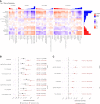Dietary metabolic signatures and cardiometabolic risk
- PMID: 36424694
- PMCID: PMC10169425
- DOI: 10.1093/eurheartj/ehac446
Dietary metabolic signatures and cardiometabolic risk
Abstract
Aims: Observational studies of diet in cardiometabolic-cardiovascular disease (CM-CVD) focus on self-reported consumption of food or dietary pattern, with limited information on individual metabolic responses to dietary intake linked to CM-CVD. Here, machine learning approaches were used to identify individual metabolic patterns related to diet and relation to long-term CM-CVD in early adulthood.
Methods and results: In 2259 White and Black adults (age 32.1 ± 3.6 years, 45% women, 44% Black) in the Coronary Artery Risk Development in Young Adults (CARDIA) study, multivariate models were employed to identify metabolite signatures of food group and composite dietary intake across 17 food groups, 2 nutrient groups, and healthy eating index-2015 (HEI2015) diet quality score. A broad array of metabolites associated with diet were uncovered, reflecting food-related components/catabolites (e.g. fish and long-chain unsaturated triacylglycerols), interactions with host features (microbiome), or pathways broadly implicated in CM-CVD (e.g. ceramide/sphingomyelin lipid metabolism). To integrate diet with metabolism, penalized machine learning models were used to define a metabolite signature linked to a putative CM-CVD-adverse diet (e.g. high in red/processed meat, refined grains), which was subsequently associated with long-term diabetes and CVD risk numerically more strongly than HEI2015 in CARDIA [e.g. diabetes: standardized hazard ratio (HR): 1.62, 95% confidence interval (CI): 1.32-1.97, P < 0.0001; CVD: HR: 1.55, 95% CI: 1.12-2.14, P = 0.008], with associations replicated for diabetes (P < 0.0001) in the Framingham Heart Study.
Conclusion: Metabolic signatures of diet are associated with long-term CM-CVD independent of lifestyle and traditional risk factors. Metabolomics improves precision to identify adverse consequences and pathways of diet-related CM-CVD.
Keywords: CVD; Diet; Metabolism; Metabolomics; Nutrition; Precision medicine.
© The Author(s) 2022. Published by Oxford University Press on behalf of European Society of Cardiology. All rights reserved. For permissions, please e-mail: journals.permissions@oup.com.
Conflict of interest statement
Conflict of interest: V.L.M. owns stock or stock options in General Electric, Cardinal Health, Ionetix, Boston Scientific, Merck, Eli Lilly, Johnson and Johnson, Pfizer, Intel and nVidia. He has received research grants and speaking honoraria from Siemens Medical Imaging and expert testimony fees on behalf of Jubilant Draximage. He has served on medical advisory boards for Ionetix and Curium. R.V.S. has served as a consultant for Myokardia and Best Doctors (concluded), is on a scientific advisory board for Amgen (ongoing) and is a consultant for Cytokinetics (ongoing). He is a co-inventor on a patent for ex-RNAs signatures of cardiac remodelling. He is a co-inventor on a patent for ex-RNAs signatures of cardiac remodelling. K.M. is also supported by a grant from Balchem. The remaining authors have nothing to disclose.
Figures




Comment in
-
Improving precision in estimating diet-disease relationships with metabolomics.Eur Heart J. 2023 Feb 14;44(7):570-572. doi: 10.1093/eurheartj/ehac616. Eur Heart J. 2023. PMID: 36424762 No abstract available.
References
-
- Anand SS, Hawkes C, de Souza RJ, Mente A, Dehghan M, Nugent R, et al. . Food consumption and its impact on cardiovascular disease: importance of solutions focused on the globalized food system: a report from the workshop convened by the World Heart Federation. J Am Coll Cardiol 2015;66:1590–1614. - PMC - PubMed
-
- Zeevi D, Korem T, Zmora N, Israeli D, Rothschild D, Weinberger A, et al. . Personalized nutrition by prediction of glycemic responses. Cell 2015;163:1079–1094. - PubMed
-
- Shoaie S, Ghaffari P, Kovatcheva-Datchary P, Mardinoglu A, Sen P, Pujos-Guillot E, et al. . Quantifying diet-induced metabolic changes of the human gut microbiome. Cell Metab 2015;22:320–331. - PubMed
Publication types
MeSH terms
Grants and funding
- HHSN268201500001I/HL/NHLBI NIH HHS/United States
- R01 HL156975/HL/NHLBI NIH HHS/United States
- K99 DK127196/DK/NIDDK NIH HHS/United States
- R01DK080739/GF/NIH HHS/United States
- HHSN268201800003I/HL/NHLBI NIH HHS/United States
- HHSN268201800007I/HL/NHLBI NIH HHS/United States
- R01 HL136685/NH/NIH HHS/United States
- K23 HL138260/HL/NHLBI NIH HHS/United States
- 75N92019D00031/HL/NHLBI NIH HHS/United States
- R01 DK080739/DK/NIDDK NIH HHS/United States
- HHSN268201800006I/HL/NHLBI NIH HHS/United States
- HHSN268201800005I/HL/NHLBI NIH HHS/United States
- HHSN268201800004I/HL/NHLBI NIH HHS/United States
- NHLBI/HL/NHLBI NIH HHS/United States

